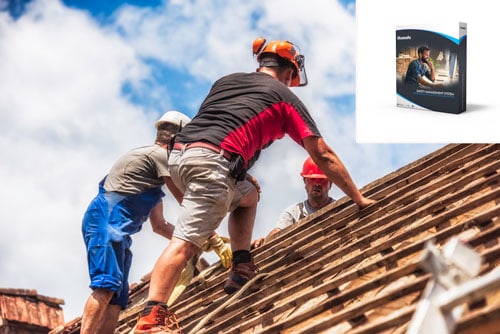As a roofing contractor, safety should always be your top priority. You want to ensure that your workers are safe and secure while on the job, and that your company is complying with all the necessary safety regulations. This is where a Roofing Contractor WHS Safety Management System can help.
Our Roofing Contractor WHS Safety Management System provides you with all the necessary tools to create and implement a comprehensive safety programme for your company. This system includes policies, procedures, forms, and Safe Work Method Statements (SWMS) that are specifically designed for the roofing industry.
The system has been developed by industry experts and is fully compliant with all current legislative requirements. We also provide 2 years of legislative update coverage, so you can rest assured that your safety programme will remain up-to-date with any changes in legislation.
The policies included in the system cover a range of safety issues such as hazard identification and risk management, emergency procedures, incident reporting, and workplace health and safety (WHS) responsibilities. These policies are designed to ensure that everyone in your organisation is aware of their responsibilities when it comes to safety, and that they know what to do in the event of an emergency.
The Industry Policy and Procedures Induction Manual for the Roofing Contractor Work Health and Safety Management System should be provided to each employee or sub-contractor and the manual includes an induction sign off page at the back, which should be signed off by each worker.
The Policy and Procedures Manual for the Roofing Contractor Work Health and Safety Management System has updated procedures for various aspects of work health and safety, including:
- Management of Health and Safety Risks
- General Tools and Equipment
- Drugs and Alcohol
- Company Vehicle Use
- Private Vehicle Use for Work Purposes
- Company Provided Mobile Phone Use
- Managing Noise and the Prevention of Hearing Loss
- Internet and Email Use
- Emergency Procedures
- First Aid Procedures
- First Aid Kit Checklist
- Hazardous Substances
- Rehabilitation
- Personal Protective Equipment
- Social Functions
- Slips Trips and Falls
- Work at Heights
- Sun Protection
- Managing Workplace Conflict
- Workplace Hazard Identification Inspections
- Incident Reporting
- Manual Handling & Hazardous Manual Tasks
- Fatigue Management
- Company and Personnel Privacy
- Smoking
- and more.
The WHS Diary Records Manual is a compilation of forms for any area of your safety compliance that needs to be recorded, which includes forms such as:
- Incident Report Form
- Hazard Identification Form
- Risk Assessment Form
- Toolbox Talk Sign-In Sheet
- Training Record Form
- Safety Inspection Form
- Personal Protective Equipment (PPE) Checklist
- Fire Safety Checklist
- Emergency Evacuation Plan
- First Aid Report Form
- Injury and Illness Record Form
- Chemical Register Form
- Safety Meeting Minutes Form
- Work Permit Form
- Equipment Inspection Form
- Job Safety Analysis (JSA) Form
- Safety Observation Report Form
- Confined Space Entry Permit Form
- Lockout/Tagout Form
- Safety Audit Checklist
As part of the Roofing Contractors Work Health and Safety Management System, we offer 30 industry-specific Safe Work Method Statements (SWMS) that are specifically selected by you.
These SWMS have been developed by industry experts and are fully comprehensive, ensuring that all major aspects of the job are covered in detail. They are also tender quality standard, which means they meet the highest standards required for larger contracts and tenders. Our SWMS are easy to use, with clear and concise instructions that make it simple for your workers to understand and follow the required safety procedures. By utilising our SWMS, you can be confident that you’re one step further in helping to make sure your workers are following best practices and that your company is moving towards complying with all necessary safety regulations and legal obligations.
Ordering and Delivery
The system will be delivered in adherence to the legislation operative in your state. If your business operates nationally, be sure to let us know in the notes section when ordering, so we can ensure your package covers all the relevant jurisdictions your business operates in.
Delivery time is 7-10 business days. However if your order is urgent you may select express delivery during checkout and we’ll have your package to you within 3-5 business days.
Gary’s Safety Tips 
Hey there, it’s great to be here with you today. My name is Gary, and I’m excited to talk about something that’s incredibly important: Working safely as a roofing contractor.
Let’s start by saying that roofing is one of the most dangerous professions out there. Working at heights, using heavy machinery and tools, and being exposed to the elements all present risks that must be taken seriously. That’s why it’s absolutely essential for roofing contractors to prioritise safety at all times.
Here are a few tips for working safely as a roofing contractor:
- Invest in quality safety equipment: As a roofing contractor, your safety equipment is your lifeline. Make sure you invest in high-quality gear that’s been tested and approved by regulatory bodies. This includes helmets, safety harnesses, non-slip shoes, and more.
- Follow WHS regulations: Safe Work Australia sets strict regulations for construction and roofing work. Make sure you’re familiar with these regulations and follow them to the letter. This includes everything from fall protection to ladder safety.
- Get proper training: Don’t assume that you know everything there is to know about roofing safety. Take the time to get proper training and certification in the use of all equipment and machinery you use, and learn the latest safety procedures.
- Stay aware of your surroundings: When you’re working at heights, it’s easy to become so focused on the task at hand that you lose sight of your surroundings. Stay aware of what’s going on around you at all times, and be on the lookout for any potential hazards.
- Communicate with your team: Roofing work is often a team effort, and communication is key to staying safe. Make sure you communicate effectively with your team members, and let them know if you see any potential hazards.
- Take breaks: Roofing work can be physically and mentally demanding. Take regular breaks to rest, rehydrate, and refuel. It’s important to stay alert and focused throughout the day.
- Don’t take unnecessary risks: As a roofing contractor, it’s easy to feel invincible. But it’s important to remember that taking unnecessary risks can have serious consequences. Always err on the side of caution, and if you’re unsure about something, ask for help.
- Stay up-to-date on safety best practices: The world of roofing safety is constantly evolving. Stay up-to-date on the latest best practices, and don’t be afraid to implement new safety measures as needed.
Remember, safety should always be your top priority as a roofing contractor. By investing in high-quality equipment, following regulations, getting proper training, staying aware of your surroundings, communicating effectively, taking breaks, avoiding unnecessary risks, and staying up-to-date on safety best practices, you can minimise the risks and stay safe on the job.
Best regards,

![]()





